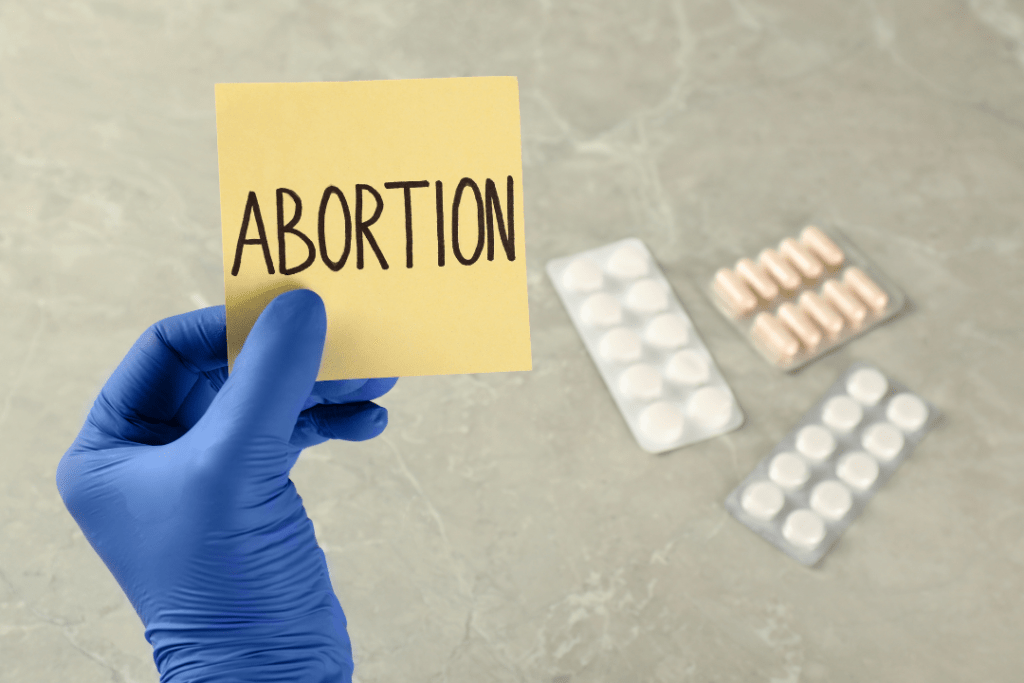Abortion is a choice people make for different reasons. Some end pregnancies due to health or fetal issues, while others stop unintended pregnancies. Often, those who have abortions may not talk about why, due to worry about being judged. People who decide to end pregnancies for any reason, should not feel judged or unsafe when they make this choice 1 and no reason for having an abortion is wrong.
Abortion vs miscarriage
are different events related to pregnancy that tend to cause strong emotions and physical changes. Although they have some similarities, they are different in where they come from and what they mean.
- Abortion – Abortion refers to the deliberate termination of a pregnancy. The decision is usually made by the pregnant woman by consulting a doctor, due to various reasons such as health concerns, personal circumstances or reproductive choices. There are two main types of abortion – medication abortion, which involves taking pills, and in-clinic abortion procedure, which is done at a surgical facility. Abortions are legally regulated in India to ensure safe and controlled access to healthcare services for those who choose this option.
- Miscarriage – It is also called a spontaneous abortion. Miscarriage is a pregnancy loss which occurs when a pregnancy is lost naturally before the fetus has become viable for survival on its own. Miscarriages are typically caused due to chromosomal abnormalities, hormonal imbalances, or other medical factors beyond the pregnant person’s control. Miscarriage symptoms might include bleeding, abdominal pain, and passing of tissue from the vagina. They can be emotionally distressing and occur without warning, affecting individuals both emotionally and physically.
It’s important to approach both abortion and miscarriage with empathy and understanding, acknowledging the diverse range of emotions and circumstances that individuals may experience. Support from medical professionals, friends, and family is crucial during these times. 2 3
Here are some of the factors that lead to abortion –
It’s crucial to recognize that the decision to have an abortion is influenced by a combination of factors, including socioeconomic circumstances, personal considerations, and legal restrictions. Let’s delve into the interconnected web of reasons behind abortion, shedding light on the importance of understanding these causes.
1. Socioeconomic factors and abortion –
- Poverty and financial instability – For many women, economic constraints play a significant role in the decision to terminate a pregnancy. Financial instability can be a huge barrier in taking care of a child. Studies show around 40% of women who seek abortions mention financial concerns as a primary factor. Approximately 4% said that not having a job played a part in their choice. Hence, a limitation in financial resources may prevent women from providing the necessary support and opportunities for a child’s well-being.
- Lack of access to healthcare – Inaccessible or unaffordable healthcare can prevent women from getting the necessary reproductive health services, including contraception and prenatal care. In regions with limited healthcare access, unintended pregnancies may occur more frequently, leading to a higher demand for abortion services. A study published by the World Health Organization (WHO) underscores the significance of universal access to reproductive healthcare in reducing the need for abortions.
- Limited educational opportunities – Education empowers women to make informed choices about their bodies and reproductive health. Unfortunately, limited access to education, particularly comprehensive sex education, can contribute to unplanned pregnancies. Research from UNICEF indicates that a lack of comprehensive sex education is linked to higher rates of unintended pregnancies among adolescents.
- Unemployment and job insecurity – Unemployment and job instability can create an environment where raising a child becomes a daunting challenge. Women may worry about their ability to provide adequate financial support, healthcare, and education for a child in such circumstances. This concern can lead some to choose abortion as a way to navigate their current economic challenges.
2. Personal circumstances and abortion –
- Rape or sexual assault – Sexual assault or rape can lead to unwanted pregnancies, presenting an emotionally distressing situation for the victim. Many women faced with this situation consider abortion as a means to regain control over their lives and bodies. Acknowledging and supporting the choices of survivors is essential in promoting their physical and mental health.
- Health concerns for the mother – In some cases, maternal health complications can pose a risk to both the mother and the potential child. Women facing severe health issues may have to make the difficult decision to terminate a pregnancy to prioritize their well-being. The American College of Obstetricians and Gynecologists emphasizes the importance of personalised care in such situations.
- Incompatibility with current life goals – Women often have personal aspirations and goals that may be incompatible with raising a child at a particular phase of their life. Pursuing higher education, establishing a career, or achieving personal milestones can influence the decision to delay or abstain from parenthood.
- Contraception Failure – Many times breakage or slippage of condoms, missing pills or using unreliable methods such as Withdrawal etc. can lead to an undesired pregnancy. Women may seek abortion due to these circumstances. This highlights the need to use appropriate and reliable methods of birth control.
- Relationship issues – The dynamics of relationships can impact decisions about pregnancy. Whether it’s a lack of partner support, an unstable relationship or a disagreement on parenting, relationship challenges can lead to consideration of abortion. Supportive relationships and open communication can play a role in shaping reproductive choices.
3. Legal restrictions and abortion –
- Inability to access safe and legal abortion services – Even though abortion is legal upto 20 weeks of the pregnancy, the availability of safe and accessible services may be limited. It can force women into seeking unsafe methods, risking their health and lives. The WHO underscores the importance of ensuring access to safe abortion services to protect women’s rights and well-being.
- Harassment and intimidation from anti-abortion groups, lack of support from partner/ family – Anti-abortion activists can subject women seeking abortion to harassment, intimidation, and misinformation. Discouragement from family, fear of social judgement for an unmarried girl and the stigma associated with abortion can make it difficult for women to reach out to appropriate healthcare services. Such behaviour can worsen the emotional distress associated with making a difficult decision. Providing a supportive and non-judgmental environment for women is crucial in these circumstances.
Second trimester abortions –
The reasons for having abortions in the second trimester overlap with those in the first trimester.
- Non-medical reasons –
According to the Kaiser Family Foundation (KFF), people might opt for later abortions due to various non-medical reasons, including –
- Discovering the pregnancy late
- Limited knowledge about accessing abortion care
- Challenges with transportation
- Lack of information life changes due to pregnancy
- Financial problems to afford the procedure
- Fetal issues –
Later in pregnancy, individuals might choose abortion due to fetal health concerns. Genetic fetal abnormalities can often be detected early. However structural issues may not be evident until a 16-18 week fetal anatomy scan. This scan uses ultrasound to visualise organ development.
Certain anomalies are severe and could lead to the fetus passing away shortly after birth of living a difficult life with major deformities. When facing such scenarios, people may make challenging decisions to end a pregnancy they otherwise would want to continue.
- Serious health risks –
Some individuals encounter life-threatening health conditions later in pregnancy. In these cases, someone might opt to terminate the pregnancy to safeguard their own life.
Conditions that could be life-threatening include –
- Severe preeclampsia
- Cancer needing immediate treatment
- Intrauterine infection with early amniotic sac rupture.
Second Trimester abortion procedure has to be done with admission to a clinical set up and with the legal approval of two Registered doctors. It may take over two days to complete a second trimester abortion at the medical centre and resembles the process of labour and delivery. Ultrasonography after 2 weeks is necessary to ensure no products of conception have remained inside.
The World Health Organization (WHO) states that approximately 73 million abortions happen worldwide every year. Out of these, nearly 33 million are not safe, and of all unsafe abortions, about one-third involve invasive procedures or untrained individuals. The WHO emphasises that unsafe abortion is a significant cause of preventable maternal deaths. It’s necessary for everyone to understand these reasons so we can talk kindly and knowledgeably about pregnancy choices. If we work on problems like poverty, limited access to healthcare, and laws that limit options, we can make a place where women’s choices are honoured, and they can decide what’s best for them.4 5






